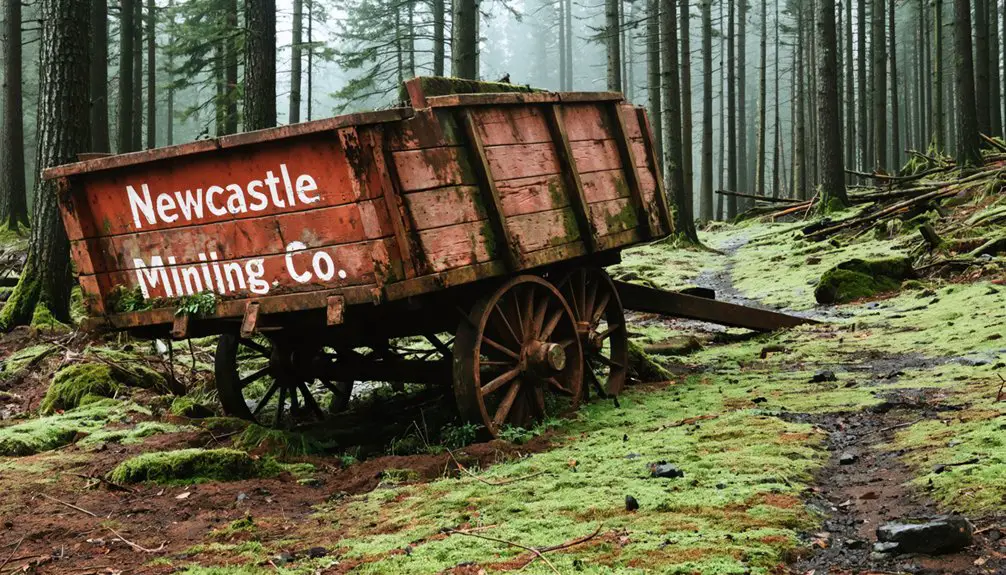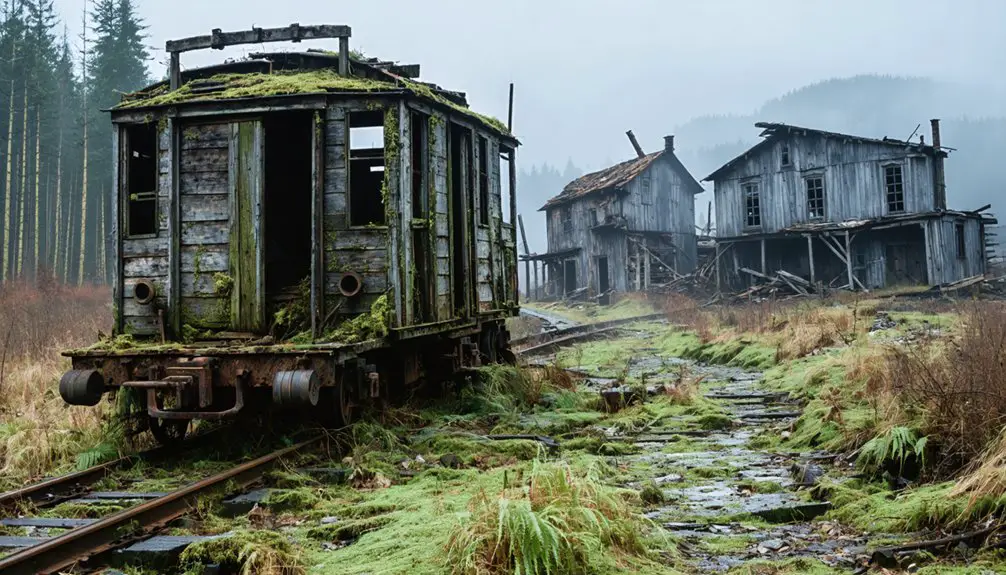You’ll find Red Town‘s ghost town remnants within Cougar Mountain Regional Wildland Park, where Newcastle’s bustling coal mining operations once produced up to 100 tons daily in the 1870s. The preserved site features old mine shafts, historic buildings like the Baima House, and interpretive trails that wind through former mining zones. This color-coded neighborhood was part of King County’s second-largest community, and its artifacts tell fascinating stories of Washington’s industrial heritage.
Key Takeaways
- Red Town was once a thriving coal mining community in Newcastle, Washington, that transformed from an agricultural village in 1869.
- The neighborhood housed essential services including schools and hotels, with company-owned houses built near mine shafts.
- Today, Red Town exists as a historical site within Cougar Mountain Regional Wildland Park, featuring preserved mining-era structures.
- Visitors can explore mining relics, old shafts, and the Baima House through the Red Town trailhead system.
- Interpretive signs along trails guide visitors through former mining zones, helping preserve the ghost town’s history.
The Birth of a Mining Town Legend

While many Western mining towns emerged from sudden gold or silver strikes, Newcastle’s transformation from a quiet agricultural village into a bustling coal mining center began more deliberately in 1869.
You’ll find its story rooted in the discovery of rich coal deposits that would yield nearly 11 million tons over the next century. Named after England’s famous coal region, Newcastle Hills quickly became King County’s second-largest community, helping transform Seattle from a village into a major port city. A vital railroad connection to Lake Washington enabled efficient transport of coal to regional markets.
Early mining techniques involved surface extraction and shallow tunnels, with miners using handpicks and explosives to access the coal seams. Tram cars with mules transported the coal from deep within the mines.
The town’s growth brought ethnic diversity, reflected in distinctly named neighborhoods like Red Town, Finn Town, and Rainbow Town, though tensions sometimes flared, as evidenced by the forced expulsion of Chinese laborers in the 1870s.
Life in Red Town’s Colorful Neighborhoods
How did Newcastle’s miners build such distinct neighborhood identities? You’d find the answer in the vibrant colors of their homes – with Red Town’s crimson houses, Rainbow Town’s multicolored dwellings, and White Town’s pale structures creating natural boundaries within the mining camp.
These color-coded communities shaped strong cultural traditions, especially in places like Finn Town, where Finnish immigrants carved out their own cultural space. Like the Mourne Mountains of its namesake in Ireland, the surrounding landscape provided a dramatic backdrop to daily life.
The community dynamics centered around company-owned houses built near mine shafts and railroad lines. One prominent example was Company House No. 180, which Milt Swanson’s family purchased in 1930.
The miners’ daily existence unfolded around clusters of company housing, strategically positioned near the mines and railway infrastructure.
You’ll discover that each neighborhood had its essential services – Red Town boasted both a school and hotel.
Daily life revolved around these shared spaces, where miners and their families blended diverse cultural backgrounds, creating tight-knit communities that defined Newcastle’s character during the coal mining era.
Peak Mining Years and Economic Growth
When coal mining began in Newcastle in 1863, you’d find miners using basic tools like handpicks and explosives to extract surface deposits from shallow tunnels.
By the 1870s, peak production soared to 75-100 tons daily, transforming this former agricultural village into King County’s second-largest community.
You’ll see how the 1870 railroad connection to Seattle sparked massive economic expansion, with Newcastle’s coal fueling Seattle’s growth and reaching markets as far as San Francisco.
Underground mining operations grew extensively, with ventilated tunnels supporting high-volume extraction. Nearly 11 million tons of coal were extracted over the century, employing hundreds of workers.
Exploring Today’s Historical Remnants
Although Newcastle’s bustling mining days have long passed, you’ll find fascinating historical remnants scattered throughout the original Red Town site. You can explore the preserved Baima House, standing as a symbol to early 20th-century miners’ housing, and discover coal mining relics like old mine shafts and tipples. The area once produced 400 to 800 tons of coal daily during peak operations.
The historic cemetery near Lake Boren and traces of original railroad grades offer glimpses into the area’s rich past.
Access these historical artifacts via the Red Town trailhead off Newcastle-Golf Course Road. Through Cougar Mountain Regional Wildland Park and Coal Creek Park, you’ll encounter various points of interest.
The Newcastle Historical Society maintains strong community engagement through events like Newcastle Days at Lake Boren Park, where you can learn about the town’s heritage and even arrange visits to preserved structures like the Pacific Coast Company house.
Natural Landmarks and Geographic Features
Located in the northwest corner of Cougar Mountain Regional Wildland Park, Red Town’s natural landscape features dense forests and lush creek valleys interwoven with 3.7 miles of moderate hiking trails. The area provides convenient trailhead access from the Red Town parking area.
You’ll encounter striking natural formations along the Indian Trail, including prominent rock outcrops and sealed mine entrances that blend into the rugged terrain. Coal Creek winds through the area, creating verdant corridors and picturesque waterfalls like Far Country Falls. The area’s native meadow restoration project showcases the region’s commitment to preserving indigenous plant species.
Far Country Falls cascades through Coal Creek’s lush corridor, where ancient mine entrances and rocky outcrops dot the untamed landscape.
The park’s ecological diversity thrives across its 100-meter elevation changes, supporting native wildlife from deer to occasional cougars. Along the Quarry Trail, you can explore historical geological features while traversing woodchip paths through the preserved suburban creek valleys.
The dense Pacific Northwest vegetation and varied topography create year-round green corridors that maintain essential wildlife habitats.
Preserving Newcastle’s Mining Heritage
Newcastle’s rich mining legacy lives on through dedicated preservation efforts spanning historic infrastructure, cultural artifacts, and archaeological sites.
The Newcastle Historical Society leads heritage conservation initiatives, maintaining sites like the historic Baima House and organizing educational exhibits during Newcastle Days at Lake Boren Park.
You’ll find tangible remnants of the mining era throughout the area, from abandoned coal bunkers to preserved railroad grades.
The Red Town trails offer interpretive signage that guides you through former mining zones, where you can spot steam hoist ruins and old tramways.
Cultural memory persists through documented oral histories and the preservation of mining-associated cemeteries.
These sites tell the stories of diverse immigrant communities, including Chinese laborers and European settlers, who shaped Newcastle’s identity during its coal-mining heyday.
Frequently Asked Questions
Is the Locomotive in Lake Boren Accessible to Divers Today?
You can’t definitively confirm if Lake Boren’s locomotive is accessible to divers today, as no documented underwater exploration or diver safety reports exist regarding this submerged historical artifact’s current condition.
What Happened to the Original Red Town Residents After Mining Ceased?
After the Great Strike of 1921 scattered 90% of Red Town’s population, you’ll find their mining legacy spread across Pacific Northwest industrial towns where families sought new work and better opportunities.
Were There Any Major Mining Accidents or Disasters in Newcastle?
You’ll find Newcastle mining accidents were severe, including an 1894 explosion killing four miners, followed by an underground fire that forced workers to divert Coal Creek to extinguish the blaze.
How Did the Different Neighborhoods’ House Colors Get Chosen?
You’ll find that miners chose house colors freely after buying homes from mining companies, creating neighborhood distinctions. Red Town’s colors likely masked coal dust, while cultural preferences shaped other areas’ color selection.
Are There Any Unexplored Mine Tunnels Still Remaining Under Cougar Mountain?
While unexplored tunnels may exist beneath Cougar Mountain, you can’t legally access them – mine exploration is restricted due to tunnel safety concerns, with entrances sealed or grated by county authorities.
References
- https://sites.google.com/site/mikebetz/places/king-county/newcastlered-towncougar-mtn-park
- https://www.newcastlewahistory.org
- https://blackdiamondhistory.wordpress.com/2015/08/14/spirit-of-old-newcastle-lives-again-in-letter-from-towns-native-son/
- https://historicalhikes.wordpress.com/2016/02/19/cougar-moutain/
- https://www.ghosttowns.com/states/wa/newcastle-redtown.html
- https://newcastlewa.gov/your_community/all_about_newcastle/history
- https://www.wta.org/news/magazine/magazine/WA_trails_01_10_Cougar Mountain.pdf
- http://caforumonline.net/CAFHandlerPDF.ashx?ID=421
- https://blackdiamondhistory.wordpress.com/2020/03/20/milt-swanson-knows-the-history-of-newcastle-coal-creek/
- https://en.wikipedia.org/wiki/Newcastle



